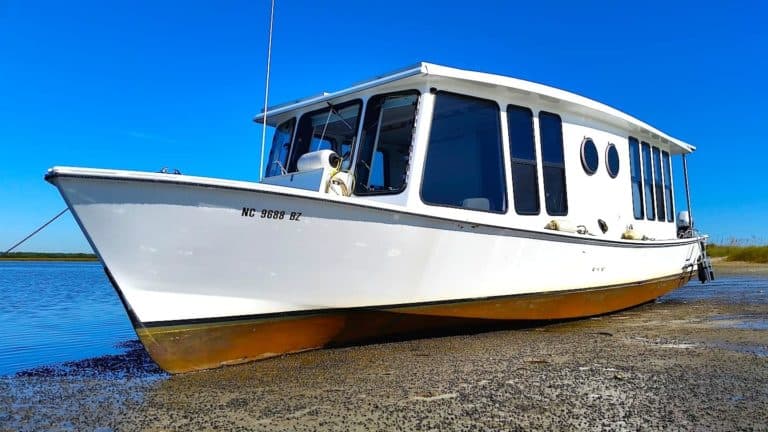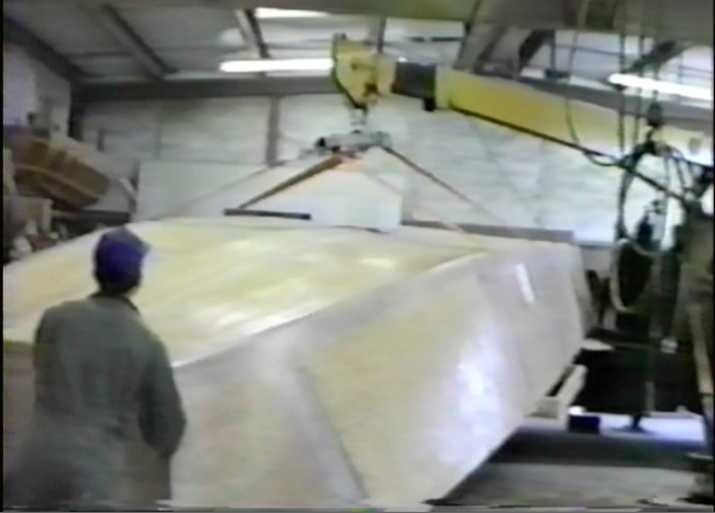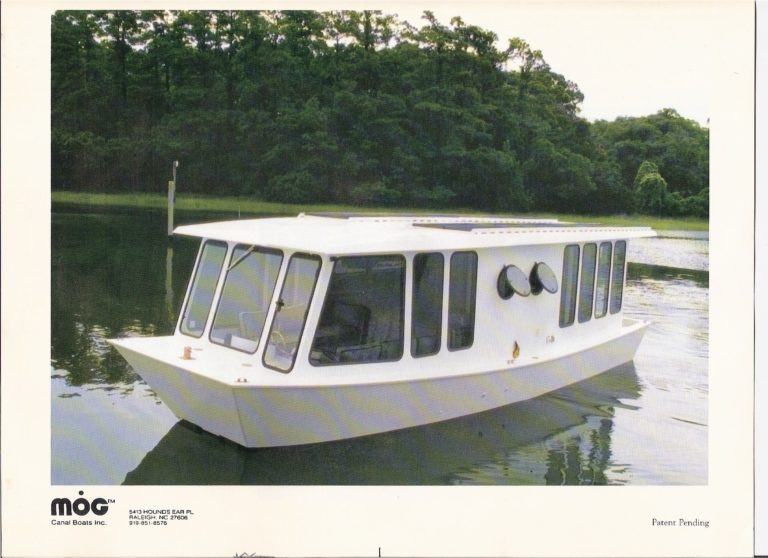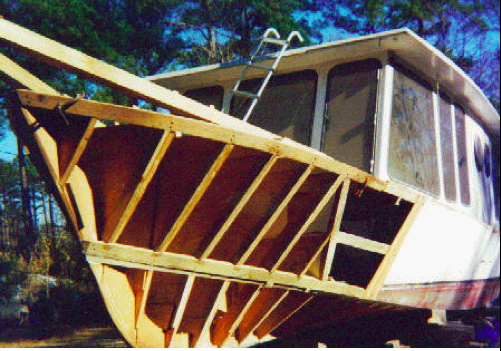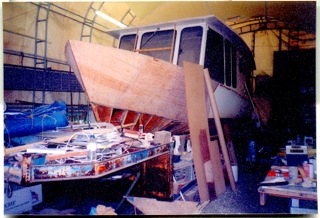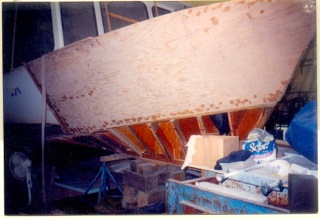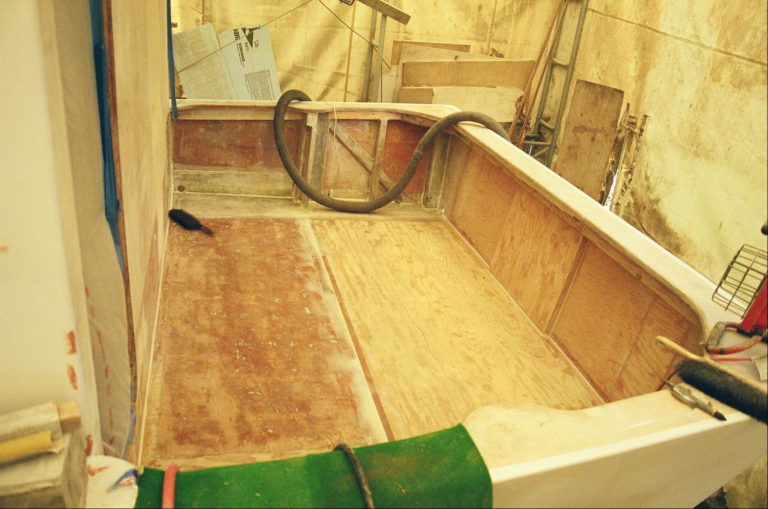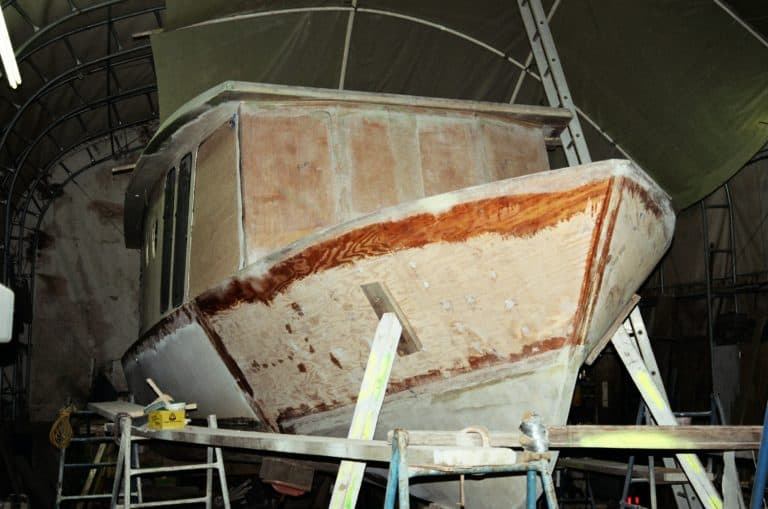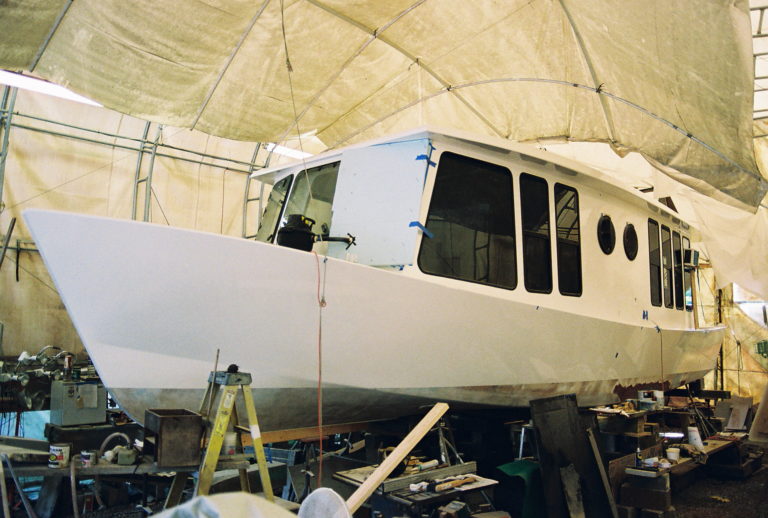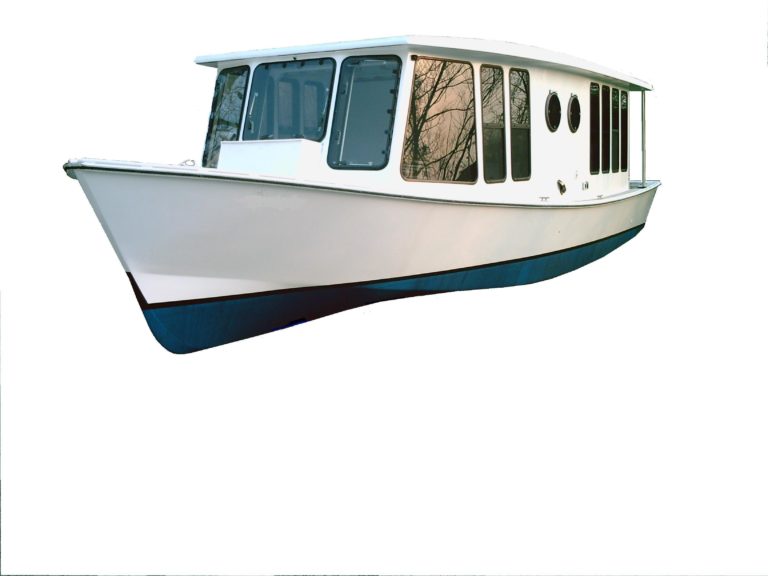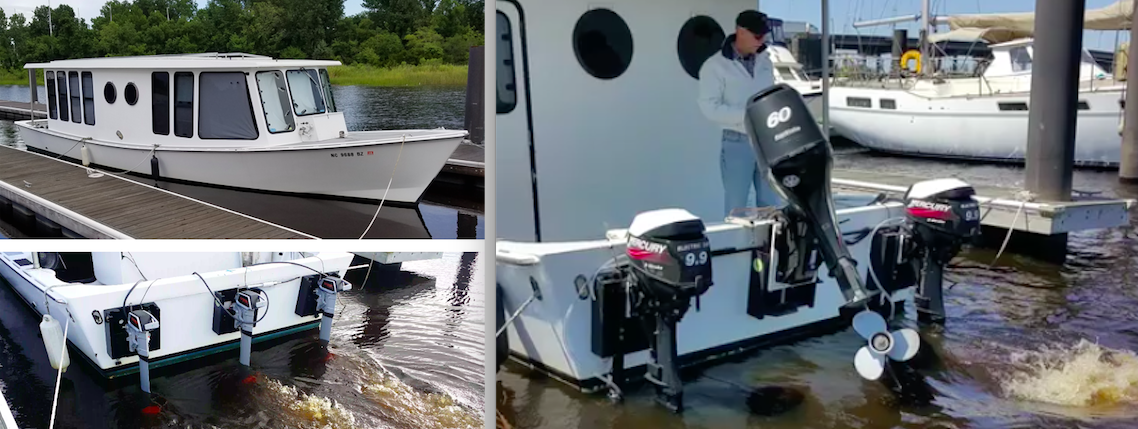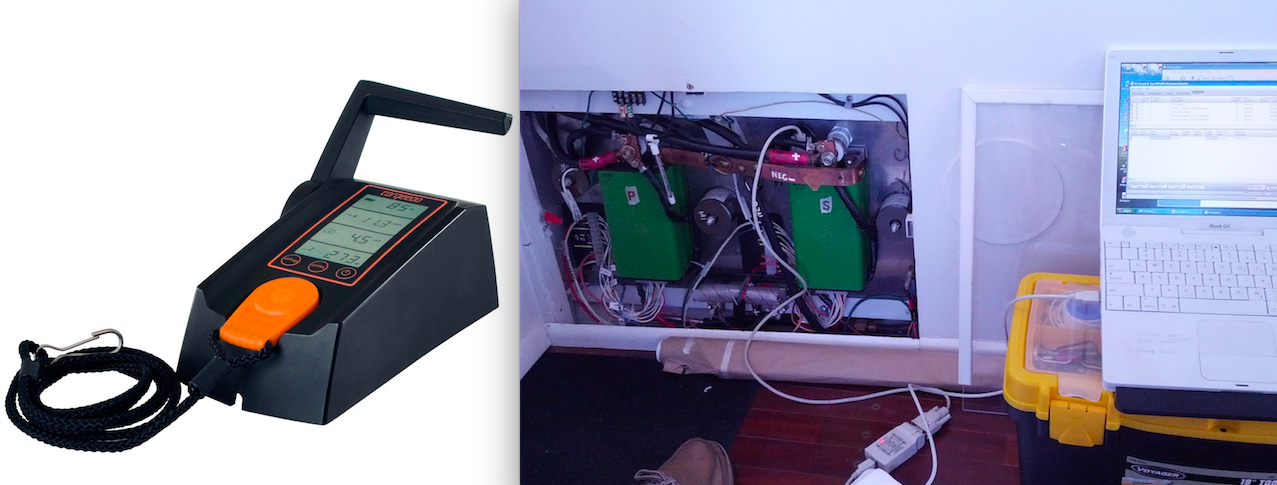CONCLUSION = New Electric Propulsion?
Testing the Torqeedo drive...
 |
No, this is not some new electric JET drive.
It is a 1,500 watt standard hair dryer
the same amount of power that drove
the ALGEMAC II Totally Electric
Powered Solar boat. |
Click on pictures to enlarge view.
At 6 tons and forty feet in length ALGEMAC II is actually a fairly lightweight cruising vessel because it is made of wood sheathed in epoxy glass fiber powered only by 24 volts direct current (DC) of Sun power. That begs the question of how little is the amount of power required to move it as compared to a pure wind powered sail boat? Answer.... your hair dryer.
Generally, sail boats need to tack from side to side in order to progress en route, therefore 6 miles per hour might translate to 4 miles per hour to equal a straight line speed. Further complications come from wind and tides both for and against its progress as well as river currents. Our hull was covered with nearly two years of 6 inch sea plant growth shown below on the boats forefoot, which was also limiting speed. Now that we have collected some hard numbers, we should be able to see the difference after a Spring haul out and cleaning of the hull with a subsequent speed run for comparison.
A typical day trip test distance was designed for about 30 miles counting the search for anchoring, crossing large wakes, skirting traffic and just making some scenic diversions. So, enter the invite from the folks of Southport, NC to display our solar boat, we accepted. Straight line distance to Southport is 26 miles plus some optional navigations comes to about 30 miles.
The test we planned dictated the minimum amount of power to maintain steering while making headway. The only way to find the actual speed and power is to make a test trip to and from Southport and also upriver and downriver on the tidal Cape Fear River. That data was collected in order to fairly assess how well the motors, batteries, solar modules, controllers and number of motors running (1, 2 or 3) that are required to safely cover the distance. Three Torqeedo motors having 2 horsepower each at a nominal 24 VDC comprise the total drive system.
SPOILER ALERT... we are talking about speeds of 3 to 5 miles per hour. If those speeds, completely negating the use of fossil fuels are anathema to your sense of water travel, please consider the hull speed of the boat is most capable of 7+ knots (8+ mph) which has been exceeded previously. That is not the test at hand.
The plan was to leave in the outflow of tide, down river to Southport in the afternoon of November 2 at 3pm at the latest. Murphy's law prevailed, in that the 24 volt DC large connectors and the 3 individual low voltage connectors were operating intermittently due to my neglect. After a scrupulous cleaning, maneuver and control became precise.
Shoving off a bit after 4:30 pm left only a few hours of sunlight, therefore stopping to anchor for the day at about 6:30 pm. If the drive were to continue, the boat would be fine to proceed but there would be no Sun to compare inflow to outflow of the solar generated energy. The speed with just one motor using just one horse power (746 watts) while passing through Wilmington and its port had been 3.2 mph. Best to reflect on the day's travel with a more clear idea for the next day's travel versus running in the dark.
Four hundred foot and larger cargo ships ply the Cape Fear River at night along with logs and various flotsam, no place for any cruiser in narrow river channels in the dark. Even anchoring behind a spit off an island, I was still awakened several times with some hefty rocking from seriously large craft, tugs and pilot boats.
Dinner was comprised of some vegetables graced by a two minute run of an instant turkey meal in the microwave (last seconds of the video clip below). The oven gulps down the battery voltage that was at 25.7 volts to 23.6 volts, then turns off, at which time the battery voltage rebounds immediately back to 25.7
The night was quite cold dipping down to 38 degrees (3 C), calling for my down comforter plus a thermal camping blanket. In the morning a small 1,500 watt electric space heater was turned on high while I dressed then into the head for a hot water wash cloth facial, electric shave and lotion. Breakfast was a glass of juice, milk on wheat & bran cereal with a chaser of coffee. Sun came up at about 7:30 and we were out about 0800 hrs fully charged at 26 volts and rising. Moving along at about 4 mph at 0824 was just amazing with no noise, plenty of power and an uncompromising view.
While running, the main battery banks were at over 24 volts all day although the helm controls report a 2 volt drain on their displays, about 22 volts DC. At this time we were running a total of just under 1,500 watts (hair dryer) power consumption. In essence, there was a balance between the amount of energy flowing from the Sun, into the battery banks against that being withdrawn by the electric motors at 4 mph.
At 2:51 pm (1451 hrs) we were passed by the Southport, NC bound Fort Fisher ferry, traveling twice our speed at about 8 knots burning diesel fuel, the smell of which hung in the breeze for a half hour. A lot of folks waved and took pictures, just so cool.
The power input versus output remained stable throughout the entire test, underscoring the the potential to replace the present roof array with lighter, more powerful and better cost per watt performance, easily increasing our speed and range. Additionally, the reduction of roof load and subsequent rocking angle would be a most welcome creature comfort from the nearly 60% weight reduction by new thin flexible solar modules.
The speed was kept to a max of 5 mph to monitor the increase of power inflow versus out flow. I found maintaining the ratio quite simple and should be amenable to control through artificial intelligence combined with landscape recognition so that the pilot may spend more time observing the realm rather than acting within it. As one who has raced motorcycles up to 160 mph on tracks, the slow pace allows just as much enjoyment at the other end of the speed scale.
Finally arriving at the Southport dock Robert and a few others from the Southport Wooden Boat Show stood by to handle the deck lines laying along the gunwale and in a jiffy the ALGEMAC II was neatly tied to the dock cleats. At 3:51 pm the arrival had been completed with the main battery bank at 25.9 volts DC and the motor controller displays catching up past 24.4. At the end of the daylight the battery bank was over 26 volts DC and I was on my way to the Appreciation Evening event at The American Fish Company, a pub at the end of the dock. BBQ, chicken, coleslaw and wine were gratefully accepted as well as positive congratulations from a number of what seemed to be a hundred guests.
The next morning the show opened at 10 AM as I scrambled to fold up the hide away queen size bed, sweep the floor, arrange the chairs clean my dishes, and bunch of trivial movements that culminated in a somewhat shipshape presentation. The streets of the town were awash in all manner of wooden boats but I was unable to get off our boat, it was mobbed most delightfully.
A visit from my wife Hillary and her friend Caroline resulted in a lovely and gracious welcoming committee. Caroline's picture of the admiral and captain sealed the day's memory.
Prizes were also awarded for various types of boats with the ALGEMAC II being the first ever electric boat category and winner.The true winner is the quaint, open, real, adorable and friendly town of Southport, NC.
After the crowd had left the bed reemerged with billowy comforters, soft pillows and enough wisps of wind to lull the tiller man to sleep. Of course there was no way to pursue a good night dreamscape without a nightcap at The Fishy Fishy Restaurant bar and a call home.
Then up at 0730, a quick cereal breakfast, free the lines and back her out single handed. It is so easy with the small three powerful electric motors because the center motor steers while the fixed port and starboard motors allow precise neutral steering in her own length radius circle. I only captured a few seconds of the initial departure as it was more prudent to steer than video at 0846 hrs.
At about 0900 hrs the tide turned toward the North and home to Wilmington, NC. As the sun and tide worked together and the combined power to the motors was regulated to just under 1,500 watts (2 hp) the GPS replied with a fairly consistent 4 to 5 mph all the 26 plus miles back to Cape Fear Marina.
Back through the City of Wilmington Port one needs to keep a sharp eye out for large ships turning in the port basin for you never can be sure of where or when a tug or vessel may change course and use your boat as a dockside fender.
Always nice to return to town through the Wilmington draw bridge. The tide action beneath the bridge has its own mind, with opposing eddy currents and swirls around the large piers and dolphins. Interesting too is a floating barge being assembled at a boat yard to be towed to Wrightsville Beach as the Commodore Club Restaurant. That should be interesting.
Back in home port at 2:16 pm (1416 hrs) on Sunday the 5th of November direct from Southport, NC in under 5 hours, no fuel, no noise, no sound and ready to go on a moments notice.
In summary, the test was to evaluate the efficiency of the whole boat and power system to operate at the lowest margin of acceptable control under moderate weather conditions. A speed guideline of 3 to 4 miles per hour was determined from previous tests that would allow acceptable control in moderate weather conditions. Together with electrical demand and collection monitoring, a determination of the additional amount of power required for higher speeds could be estimated.
The test indicates a need for almost twice the power as now available from the roof array into the battery storage banks. 5,000 watts of collection of the Sun's light from atop the boat is a number that appears to satisfy the requirement of 7 mph (6 knots) with a clean hull and in moderate weather conditions. That speed would last for about 6 hours WITHOUT degrading the battery banks, as the Sun's energy would proceed nearly directly to the motors.
A supplier of lightweight, powerful and efficient solar modules has been located on the west coast for an order of 30 to 32 modules to replace the heavy 11 modules now employed. As a private venture the costs are all borne by yours truly. Moving on from 2,585 watts to 5,000 watts is exciting, expensive and time consuming but the outcome should be quite impressive to see a 12,000 pound 40 foot yacht for 2+ voyagers to travel at 6 knots with no apparent fuel or noise on three hair dryers worth of electricity.


















